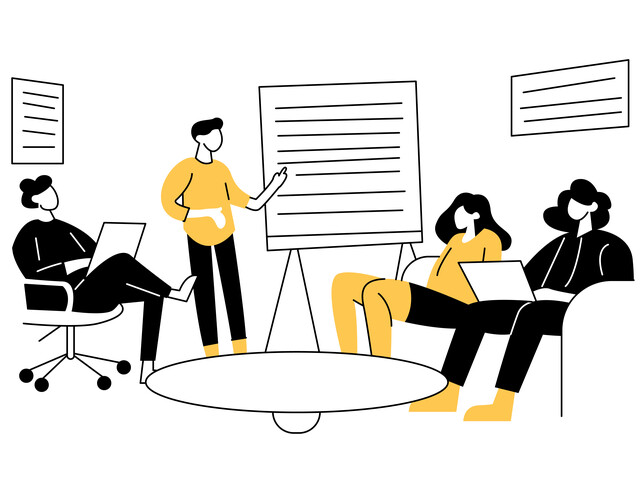Introduction
When people call customer service, they are looking for something, whether it is to place an order, get the answer to a question, or lodge a complaint. They want the person on the other end of the phone to listen and acknowledge what they need. This article will help you hone your listening skills to provide the best possible service to your customers.Listening or Hearing?
Imagine how irritating that would be for customers if you admitted that, while you could hear them talking, you were not really listening to what they were saying. They would think that you did not consider what they were saying was important, and you could very well lose them as customers.
To practice your listening skills, try listening to talk radio or news specials on television without actually watching the program. This encourages you to focus on the sound rather than the images. Listen for inflections and try to determine how each speaker feels about the issues being discussed. Take notes on the key points and ideas, then review them later to see how much you can remember about the program and the topics that were discussed.
You may be surprised to realize that you do not recall as much as you thought you would. If this is the case for you, practice some more and see if you can improve the quality of the notes you take. Remember, you do not have to write complete sentences when taking notes. Writing down key words and phrases and using punctuation is often just as effective and gives you more time to focus on listening.
It is also crucial to let the other person know you are paying attention. When you talk face to face, they can read your interest in your facial expression and gestures. Over the phone, they may be worried that you are not focusing. Make sure you are not shuffling papers or doing other activities that they may hear and interpret as inattention.
Periodically using short phrases such as "I understand," "uh-huh," or "yes" will let them know you are paying attention. Be sure you do this during lulls in the conversation rather than interrupting the caller, however. Do not be afraid to ask a question if you need to. Repeating what they say indicates interest and lets the customer know you are determined to fully understand.
Four Steps to Active Listening
Fully listening to customers takes effort and concentration on your part. The following steps will make it easier:
-
Make sure you can hear. Do not have a radio playing in the background or other distractions that will interfere. If you need to close your door or use earphones to screen out background noise, do it. You do not want other sounds to make the customer's conversation difficult to follow.
-
Interpret carefully. Take into account the speaker's stress level, experience, knowledge, vocabulary, and cultural background. Whenever you can, give the speaker the benefit of the doubt, and be sure you confirm anything you suspect from the conversation. Misinterpreting what a person says can cause hard feelings, as well as errors.
-
Evaluate. Determine what customers want and what you can do to satisfy them. How will you proceed? Part of this is making sure you understand the problem clearly and knowing what they expect of you. Visualizing the problem can be very helpful in evaluating the situation.
-
Respond. There are two simple parts of responsive listening: acknowledging the speaker's need and responding in a positive manner. This does not always mean you have to give customers what they want, but it does mean giving them the impression that you recognize and acknowledge their concerns.
Common Listening Mistakes
There are some mistakes customer service representatives make with alarming frequency that unfortunately can be very off-putting to your customers. When you are talking with clients, keep these mistakes in mind and avoid them:
- Assuming. Just because you frequently receive calls about damaged merchandise, do not assume that every complaint will be about this. Do not assume you know halfway through an explanation from a client that you know where the conversation is headed. This kind of early interpretation can lead you to offer a premature � and incorrect � solution or direct the customer to the wrong person or department for an answer.
- Interrupting. If you interrupt halfway through a sentence to ask a question or suggest an answer, the customer gets the message, "You are not important to me," or "I am in a hurry." Allowing others in the office to interrupt your calls sends the same message.
- Making up the answers. If you do not have an answer, never make one up. Your customers may temporarily feel better, but when they realize you have fabricated the information, they will be more upset than they would have been if you had been honest. Understanding and honesty are better in the long run. Tell your customer you do not know the answer but will work to resolve the situation as quickly as possible.
- Overreacting. Do not allow a customer's language or demeanor to get the best of you. It can be tempting to snap back or trade insults, but it is never in the best interests of your company. Take a deep breath, count to ten, and focus on being even more helpful and polite in order to defuse the situation. If you cannot, it is best to pass the call along to someone else.
Keeping the Conversation Going
A conversation that becomes stilted or slows to a halt means you have not handled your end of the conversation well. Remember, as a customer service representative, you are expected to handle even the most difficult conversations with skill and lead them in a positive direction. In this section, we will discuss ways to keep the conversation going and make sure customers believe you are truly serving their needs.
Asking the Right Questions
There are three types of questions you should ask during the length of a customer service call � without interrupting the speaker! These questions can be referred to as informational, probing, and confirmation questions. Each serves a particular purpose during the course of a discussion.Informational Questions
In most cases, customers are happy to give you this information, knowing it is necessary to establish who they are and get their details in front of you. Sometimes, however, customers may be so upset when they call that asking any informational questions only further inflames them. When this happens, do not react defensively by saying, "You will have to tell me the order number before I can help you." This will only anger them, and you will sound condescending.
Acknowledge the customer's anger or frustration first, then explain briefly why you need the information:
"I understand you're concerned about your order, and I'd like to resolve this for you. If you could give me your order number or an address, I'll be able to get the information we need more quickly so we can see what's going on."
The example above gives customers the feeling that you sympathize with their frustration and are ready to help. Once they understand why you are asking informational questions, they will be much more likely to volunteer as much information as you need.
Probing Questions
Probing questions are the same questions that successful reporters use to "get the story." They are sometimes referred to as the "five Ws." By asking who, what, where, when, and why, you can flesh out the details of the customer's needs or concerns.
If the person calls asking for assistance selecting a dress but is not sure of the item number, you can ask, "When did you see this in our catalog?" or "What style and color was the dress you're interested in?" and other leading questions that will help you find what they are looking for.
If the customer has a problem with a repairman or delivery, ask questions such as, "When was the delivery made?" and "Do you remember who made the delivery?" as well as "What happened that upset you when the product was delivered?"
Confirmation Questions
"What would resolve this problem to your satisfaction?"
"Could we send another repairman to take a look at the dryer for you later this week?"
"Let me be sure I understand this, Ms. Wheeler. You say your package arrived with the dishes shattered?"
"Would you like me to research this a bit more for you and give you a call back this afternoon?"
You will need to be particularly careful when asking leading questions. In some situations, the customer may misinterpret the questions as impertinent or sarcastic. Always be aware of the tone and inflection of your voice. Remain sincere and polite at all times!
Be Willing to Compromise
Although you may think some customers are making unreasonable demands or asking for too much, never let them feel that your responses are carved in stone. Customer service, in order to be effective, must always be willing to compromise, or at least give the customer the impression that you have made every effort to do so.
Phrases such as "We don't do that," and "That's against company policy," will alienate your customers.
Look for words and phrases that can soften the blow without lying to your customer. Perhaps you can say, "Although we don't usually issue refunds, let me investigate this for you, since your situation is unusual." Even if the answer is still no when you call back, the customer will appreciate that you went the extra mile to try to resolve the situation to her or his satisfaction.
Lead Gently
For instance, if your caller wants an immediate refund but does not have a receipt, ask questions that may lead to the information you need by another route.
Ask him when he made the purchase: "Mr. Leeds, let's see if we can figure this out together. By any chance, do you remember how long ago you purchased the television? Would it have been a week ago, or more like a month? Great! Okay, so it was in May. Do you happen to know if you put it on your credit card? You did? Wonderful! I think we can track down you order with this information."
Be Approachable
A recent study showed that 85 percent of people who had made customer service calls in the last year were upset if they had to call more than once about a situation and could not reach the same customer service representative. The customers resented having to retell their story and felt undervalued when they could not reach the same person they had talked to before.
Always introduce yourself to the customer at the beginning of your conversation! Make sure the speaker on the other end heard your name clearly. If you use ticket or order numbers, be sure to give that information to the customer along with your telephone extension number if it becomes apparent that you will have to transfer your call or get back to them later. This way, the customer will be able to easily contact you again if the call is cut off or you are not able to get back to them when you had hoped.
























